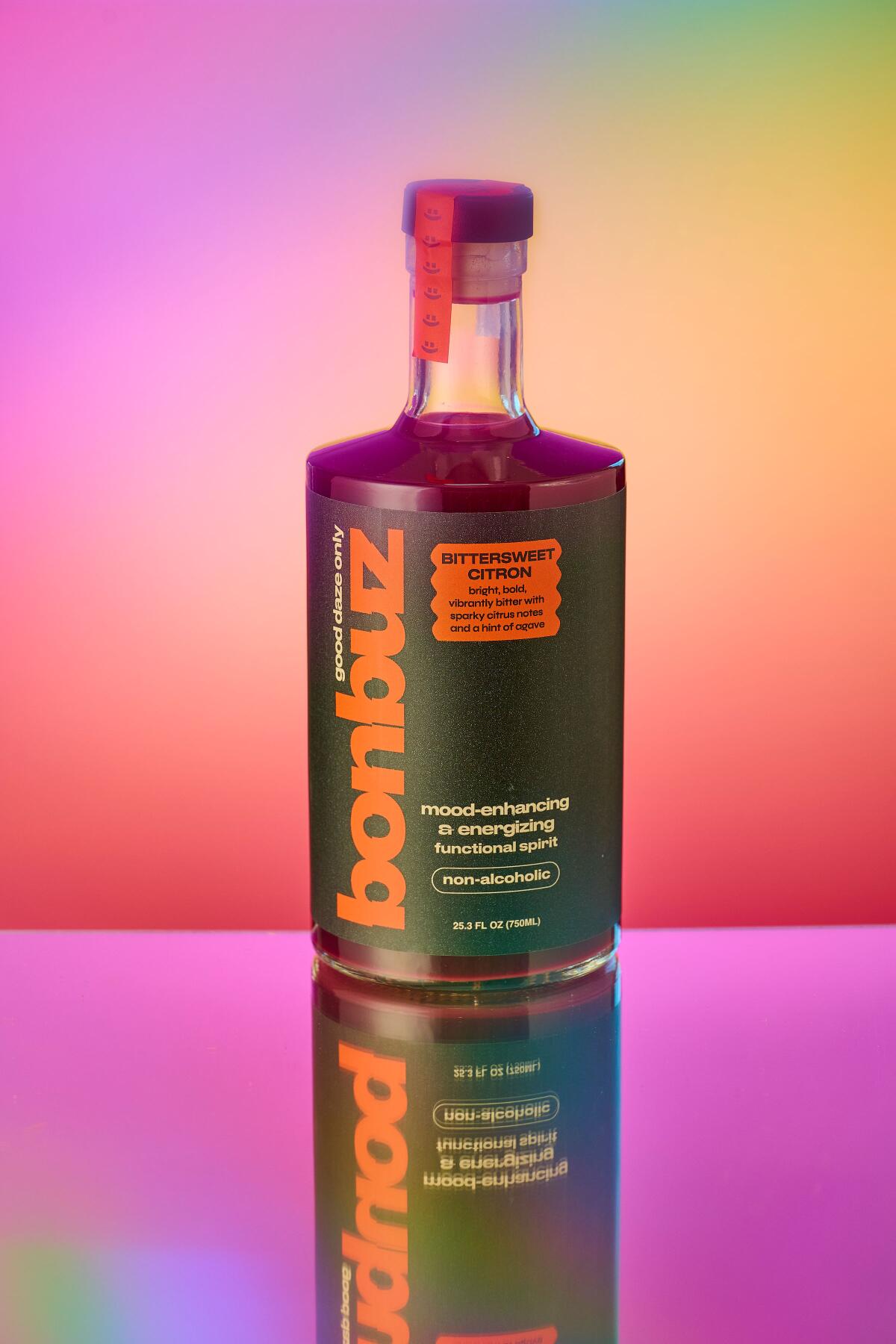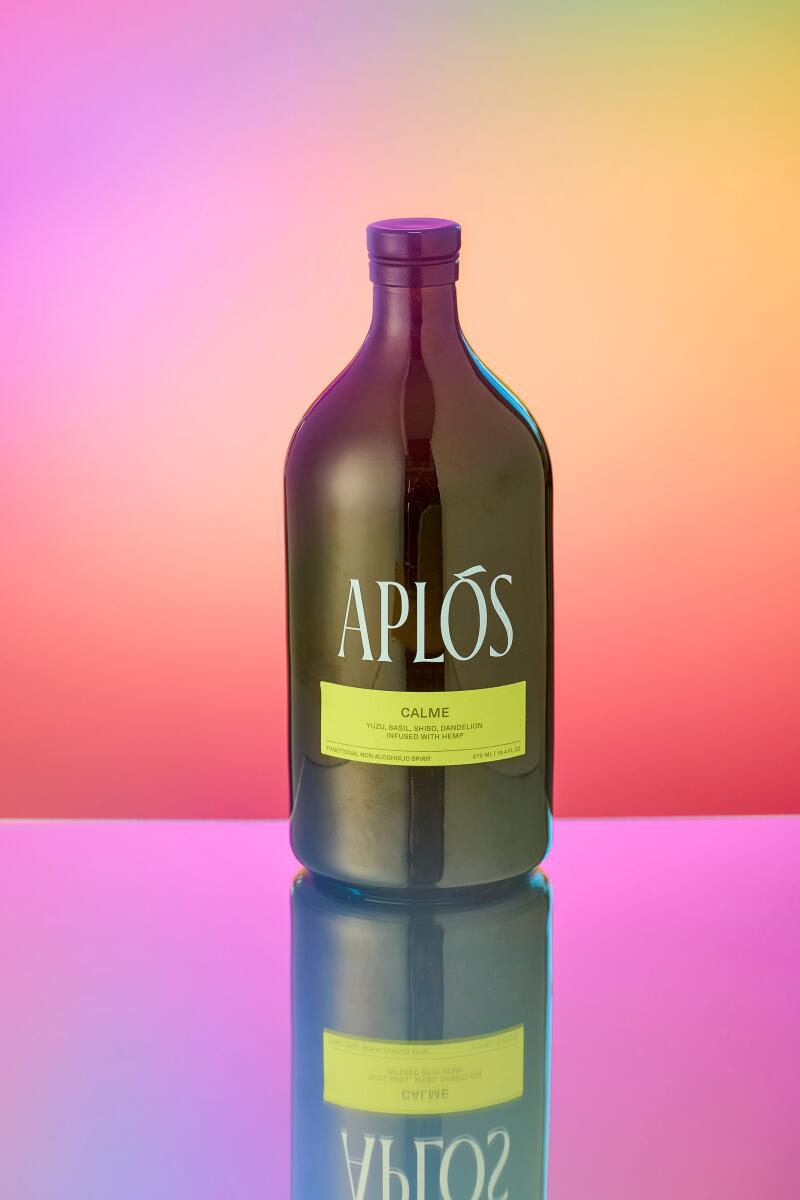Lifestyle
Can this trendy ingredient in Erewhon's drink aisle really boost your mood or help your anxiety?

Licorice root, reishi mushrooms and vitamin B-6 are often among the ingredients listed in various adaptogenic drinks.
(Rebecca Peloquin / For The Times)
It’s not enough for a drink just to taste good anymore. Most specialty grocery or liquor stores now offer colorful cans and bottles that advertise so-called adaptogens, ingredients that beverage companies claim can help you manage stress, enhance creativity and sharpen focus. With packaging printed with bright colors and trendy fonts, these drinks are designed to pop on the shelves and on your social media feed — a subtle health flex for the aesthetically conscious and sober-inclined.
You can find them in trendy superettes around the city. Silver Lake’s Soft Spirits’ adaptogenic section includes a Spritz Italiano from L.A.-based De Soi (founded by Katy Perry and Morgan McLachlan), a concoction containing Reishi mushroom, which the company claims is “a stress soothing, brain boosting botanical often referred to as ‘the herb of immortality.’” At Bristol Farms across the city, you can pick up Bonbuz, a blood red tonic that promises to “heighten your senses and transport you to a deeper mind-body experience” with ingredients like pyridoxine-HCL (a vitamin-b6), ginger root and rhodiola rosea. Or you can grab a hemp-infused chili margarita by Aplos at the Dream Hotel in Hollywood that says it can “elevate mood, stimulate brain function and boost energy.” In Erewhon, you can’t throw a gluten-free turmeric chicken tender without hitting a canned beverage touting its adaptogenic qualities.

Bonbuz Bittersweet Citron, a non-alcoholic spirit with citrus, ginger and gentian.
(Rebecca Peloquin / For The Times)
But the appeal for consumers goes beyond smart marketing and playful design. The adaptogenic drink market is booming, as research shows that young people are less and less interested in alcohol and seek healthy alternatives. (Gen-Z drink 20% less than millennials, which is perhaps why Anheuser-Busch InBev projects one-fifth of their sales to be from non- and low-alcohol beers by 2025). The global market for these beverages is set to reach $1.2282 billion by 2024, with the projected valuation increasing to $2.4168 billion in 10 years.
A TikTok video from last fall that highlights different types of adaptogenic drinks has been viewed over 1.2 million times. In the comments, viewers ask where they can buy them and share their experiences.
“I love these drinks,” one user writes. “I have horrible anxiety and some of them calm me and make me feel warm and fuzzy lol.”
Though adaptogenic drinks are relatively new to Western consumers, the term “adaptogen” has been around since 1947, when it was coined by the Soviet scientist Nikolai Lazarev who was searching for stimulating substances during the Cold War.
“Adaptogens are made from herbs, roots, and other plant materials that may help our bodies deal with and manage stress or restore homeostasis after stressful situations,” said Dana Ellis Hunnes, a senior clinical dietitian at UCLA Medical Center and assistant professor at UCLA Fielding School of Public Health, in an email. “Some of these stressors can be physical (a small burn), physiological (burnout from work and the toll that takes on our bodies) or psychological (emotional stress).”
Examples of common adaptogens are ingredients like rhodiola (a root promoted to increase stamina), ashwagandha (a shrub promoted to reduce stress and fatigue), licorice and reishi mushrooms, which have been used as traditional Chinese and Ayurvedic medicines for centuries.
Today, those same ingredients are showing up in adaptogenic supplements and beverages, but their medical value is debated. In the Food and Drug Administration’s book, adaptogens are categorized as supplements and thus not regulated the same way drugs are. For that reason, it’s hard for medical experts to make blanket statements about their efficiency or even their safety.

Licorice root, reishi mushrooms and vitamin B-6 are often among the ingredients listed in various adaptogenic drinks.
(Rebecca Peloquin / For The Times)
“It’s unknown whether the dose that most people can buy of adaptogens on the market are high enough to produce a medicinal effect,” Ellis said. ”So, what you think you’re buying, may not actually contain as much [or may sometimes contain more] than you think.”
Depending on the person, some adaptogens may even cause nausea and stomach problems. (Those who are taking specific medications, pregnant or breastfeeding should first seek guidance from their healthcare provider before consuming them.) Clarity about adaptogens’ efficacy is further muddled due to the fact that most research on these ingredients comes from animal or in-vitro studies that Nicholas B. Tiller, a senior researcher at the Institute of Respiratory Medicine & Exercise Physiology, noted in an email “are not necessarily applicable to the real world.”
“The few human studies [on adaptogens] are largely disappointing,” he said. “It’s going to require a lot more high-quality evidence before these herbs and other natural products are extensively incorporated into medical practice.”
But do most adaptogenic drink consumers see their consumption of these beverages as explicitly medicinal, or are they simply weighing their options and picking something less altering than a beer and more novel than a seltzer?
“When we initially opened our doors [in 2021], a lot of customers asked ‘what’s the point?’ and had a difficult time wrapping their heads around why anyone would want a cocktail without alcohol,” said Jillian Barkley, Soft Spirits Founder & CEO, in an email. She found these beverages — although harder to acquire back then — hugely helpful when she stopped drinking five years ago.


Aplos Arise, a non-alcoholic spirit infused with adaptogens. De Soi, a non-alcoholic aperitif made with natural adaptogens. De Soi is a company co-founded by Katy Perry and Morgan McLachlan. (Rebecca Peloquin/For The Times)
“Shopping at Erewhon and buying Kin makes you a part of a certain in-crowd, and people are seeking belonging.”
— Nikita Walia, brand strategist
“For those folks, the possibility of a physical effect tends to be enticing,” she said. “‘So you’re telling me I can drink this nightcap and it will help me feel relaxed, but I won’t be intoxicated?’ Yep!”
Nikita Walia, brand strategist and founder and CEO of BLANK, thinks the popularity of adaptogenic beverages will only gain more steam with consumers as our culture puts a higher premium on health and wellness.
“Having a beverage that is a social tonic, well-branded and aesthetically pleasing as a stand-in for alcohol is a perfect substitute,” Walia said in an email. She adds that many of these drinks are expensive and seen as luxury items only adds to their appeal.
“Shopping at Erewhon and buying Kin makes you a part of a certain in-crowd, and people are seeking belonging.”
In other words, whether adaptogenic drinks can actually elevate your mood might not matter — as long as they can elevate your social status.

Lifestyle
In 'Kinds of Kindness,' the cruelty is the point : Pop Culture Happy Hour

Lifestyle
57 California native plants that survived the Ice Age to live on today

At the La Brea Tar Pits and Museum, Jessie George and other paleobotanists — the folks who study ancient plants the way paleontologists study prehistoric bones — are compiling a list of California native plants that survived the Ice Age and the region’s first huge climate change and are still alive today.
The researchers believe we have much to learn from these resilient plants that adapted after millennia of severe temperature change, drought and wildfire that changed Southern California from moist and cool woodlands to the dry, shrubby chaparral landscape we see today.
Maybe, they say, these hardy plants can help our urban landscapes weather our current climate change.
Note that not all these survivors would be happy living near the Tar Pits today, and those are marked with an asterisk (*). Most pines, for instance, prefer wetter, cooler parts of the state, like the Central Coast, George said, and would not fare well in Southern California’s hot, dry climate.
If you have a question about whether a native plant would work well in your area, talk to the experts at places like the Tree of Life Nursery and Theodore Payne Foundation, or consult the California Native Plant Society’s handy native plant database at Calscape.
For more on these Ice Age survivors, read our July 1 L.A. Times Plants newsletter.
Trees/tall shrubs
- Monterey cypress (Hesperocyparis macrocarpa)
- Cypress (Hesperocyparis sp.)*
- California juniper (Juniperus californica)
- Rocky Mountain juniper (Juniperus scopulorum)*
- Bishop pine (Pinus muricata)*
- Monterey pine (Pinus radiata)*
- Pine (Pinus sp.)*
- Torrey pine (Pinus torreyana)*
- Blue elderberry (Sambucus mexicana)
- American dogwood (Cornus sericea)*
- Eastwood manzanita (Arctostaphylos cf. glandulosa)
- Big berry manzanita (Arctostaphylos glauca)
- Coast live oak (Quercus agrifolia)
- Scrub oak (Quercus dumosa)
- Southern California black walnut (Juglans californica)
- California sycamore (Platanus racemosa)
- Box elder (Acer negundo)
- Willow (Salix sp.)
Grasses/rushes
- Sedge (Carex sp.)
- Spikerush (Eleocharis sp.)
- Fimbry (Fimbristylis sp.)
- Barley (Hordeum sp.)
Shrubs/vines
- Big saltbush (Atriplex lentiformis)
- Poison oak (Toxicodendron diversilobum)
- Baccharis (Baccharis sp.)
- Ceanothus (Ceanothus sp.)
- Chamise (Adenostoma fasciculatum)
- Toyon (Heteromeles arbutifolia)
- California blackberry (Rubus ursinus)
- Grape (Vitis sp.)
- Parish’s purple nightshade (Solanum parishii)
Perennial herbs
- Bur-reed (Sparganium eurycarpum)
- Water parsley (Oenanthe sarmentosa)*
- Ragweed (Ambrosia psilostachya)
- Deltoid balsam root (Balsamorhiza deltoidea)*
- Thistle (Cirsium sp.)
- Aster (Symphyotrichum sp.)
- Blue-eyed grass (Sisyrinchium bellum)
- Willow dock (Rumex salicifolius)
- White water buttercup (Ranunculus aquatilis)*
- Three-petaled bedstraw (Galium trifidum)*
Annual herbs
- Sunflower (Helianthus annuus)
- Common madia (Madia elegans)
- Clustered tarweed (Deinandra fasciculata)
- Cocklebur (Xanthium strumarium)
- False rosinweed (Osmadenia tenella)
- Fiddleneck (Amsinckia sp.)
- Phacelia (Phacelia sp.)
- Carolina geranium (Geranium carolinianum)
- Parry’s mallow (Eremalche parryi)
- Red maids (Calandrinia menziesii)
- Miner’s lettuce (Claytonia perfoliata)
- Water montia (Montia fontana)
- Little spring beauty (Claytonia exigua)*
- California poppy (Eschscholzia californica)
- Purple owl’s clover (Castilleja exserta)
- Nuttall’s snapdragon (Antirrhinum nuttallianum)
Lifestyle
What does 'The Bear' restaurant review say? We take our best guess

Jeremy Allen White as Carmy Berzatto.
FX
hide caption
toggle caption
FX
Haven’t watched the season finale of The Bear yet? Then you probably don’t want to read this. Don’t blame us for spoilers.
So what does that review say?
At the end of the third season of The Bear, Carmy (Jeremy Allen White) looks at his phone late one night and sees a review of his new restaurant, The Bear, in the Chicago Tribune. All we see are flashes of words and phrases, some seemingly good and some seemingly bad, and then Carmy says, “mother——,” and that’s the season.
And look: The idea is to leave you uncertain about what the review says, and to be clear, the review could say a lot of things. Trying to decode the words we can see and come up with an idea of whether this is a good or a bad review is rank speculation. Rank, I say! So let’s speculate.
I’m really not excited to reveal how long I spent doing this, but what I am about to show you is the best rendering I can manage of the words (and parts of words) that they show in this little sequence. I present them in the form of a poem, since I can’t offer you screenshots. (These groups of words, of course, are undoubtedly not in this order in the actual review. And yes, I think this is a show that’s probably playing fair; I think these probably are all consistent with the actual review that we will eventually learn much more about.)


of flavors both d
the confusing mis
any apprehension
an almost sloppy fas
f innovative d
nu was a testa
complex array
, as each dish arrived, there
were excellent, sho
rt, leaving me fee
focus on pushing
true culinary gem
my experience at
tto, offering a
palpable dissonance b
ng the chef’s brilliant cr
disappointed and craving
Feeling disapp
and downs, t
inconsistent
as resting on
undeniable inco
of delicious pe
tchen couldn’t
e. However,
was simple an
s the potential
Berzatto p
s not subtract f
felt overdone
incredible
Carmen Berzatto

re tired a
t stale a
talent
Clear as day, right?
For my money, the most interesting phrase comes from the screen that highlights the word “delicious.” Below that, you can see “tchen couldn’t.” My guess is that the full review uses the words “kitchen couldn’t.” And I’m going to further guess that “undeniable inco” is part of something like “undeniable inconsistency” or “undeniable incompleteness” — in other words, something negative. And in the middle, the word “delicious.”
So: what if the review is basically saying that there is an inconsistency in the operation because the kitchen isn’t doing a solid enough job?
That would also fit with this bit right here:
tto, offering a
palpable dissonance b
ng the chef’s brilliant cr
disappointed and craving
Feeling disapp
Now, the “tto” is probably the end of Carmy’s name (although I suppose a word like “risotto” is possible). But right in the middle, you have “the chef’s brilliant cr,” which might be “the chef’s brilliant creations” or “the chef’s brilliant creativity” or something like that. And before that, you have “dissonance.” And after it, “disappointed.” Again, what if this is saying Carmy is a brilliant genius, but something is amiss in the staffing and the execution?
Could this also be what “an almost sloppy fas” is about? What if that says the dining room — Richie’s beloved dining room — operates in an almost sloppy fashion? It also occurred to me that it could be a reference to The Beef, that The Beef was “almost sloppy fast food” or something. Or perhaps Neil Fak is a little too sloppy for this reviewer’s refined tastes.
Here’s another interesting part:
f innovative d
nu was a testa
complex array
That middle line should be “menu was a testament,” right? The menu is a testament to something? Probably Carmy’s brilliance? The changing menu he’s been obsessed with? And that would fit with “f innovative d,” which could be, say, “of innovative dishes.”
A prediction
Go back and read it all, like a poem, all together, and let it wash over you. Here’s what I think the review might say: Carmy is an amazing chef, full of potential, creative and amazing. But the rest of the team is not living up to his great ideas. In other words, I think the review says everybody else at The Bear needs to get on Carmy’s level.
If it says that, then that would explain why, after reading a review that (probably) calls him “brilliant,” he swears angrily. It would also complicate his obsession with his own standards to see the system he insisted on (the changing menu especially) wind up making him look good, but interfering so much with how the place runs that other people look bad.
I want to stress that if this is all completely and totally wrong, it will be no surprise. The whole thing could be a misdirect, every word could be misleading — “the chef” might not be Carmy, “nu” could be “Keanu” instead of “menu,” you get the idea.
But to me, it would be consistent with this season if Carmy had the most pyrrhic of pyrrhic victories, and this review gave him what he wanted at the expense of the people he works with.
-

 News1 week ago
News1 week agoRead the Ruling by the Virginia Court of Appeals
-

 News1 week ago
News1 week agoTracking a Single Day at the National Domestic Violence Hotline
-

 Fitness1 week ago
Fitness1 week agoWhat's the Least Amount of Exercise I Can Get Away With?
-

 News1 week ago
News1 week agoSupreme Court upholds law barring domestic abusers from owning guns in major Second Amendment ruling | CNN Politics
-

 Politics1 week ago
Politics1 week agoTrump classified docs judge to weigh alleged 'unlawful' appointment of Special Counsel Jack Smith
-

 Politics1 week ago
Politics1 week agoSupreme Court upholds federal gun ban for those under domestic violence restraining orders
-

 Politics1 week ago
Politics1 week agoNewsom seeks to restrict students' cellphone use in schools: 'Harming the mental health of our youth'
-

 Politics1 week ago
Politics1 week agoTrump VP hopeful proves he can tap into billionaire GOP donors















